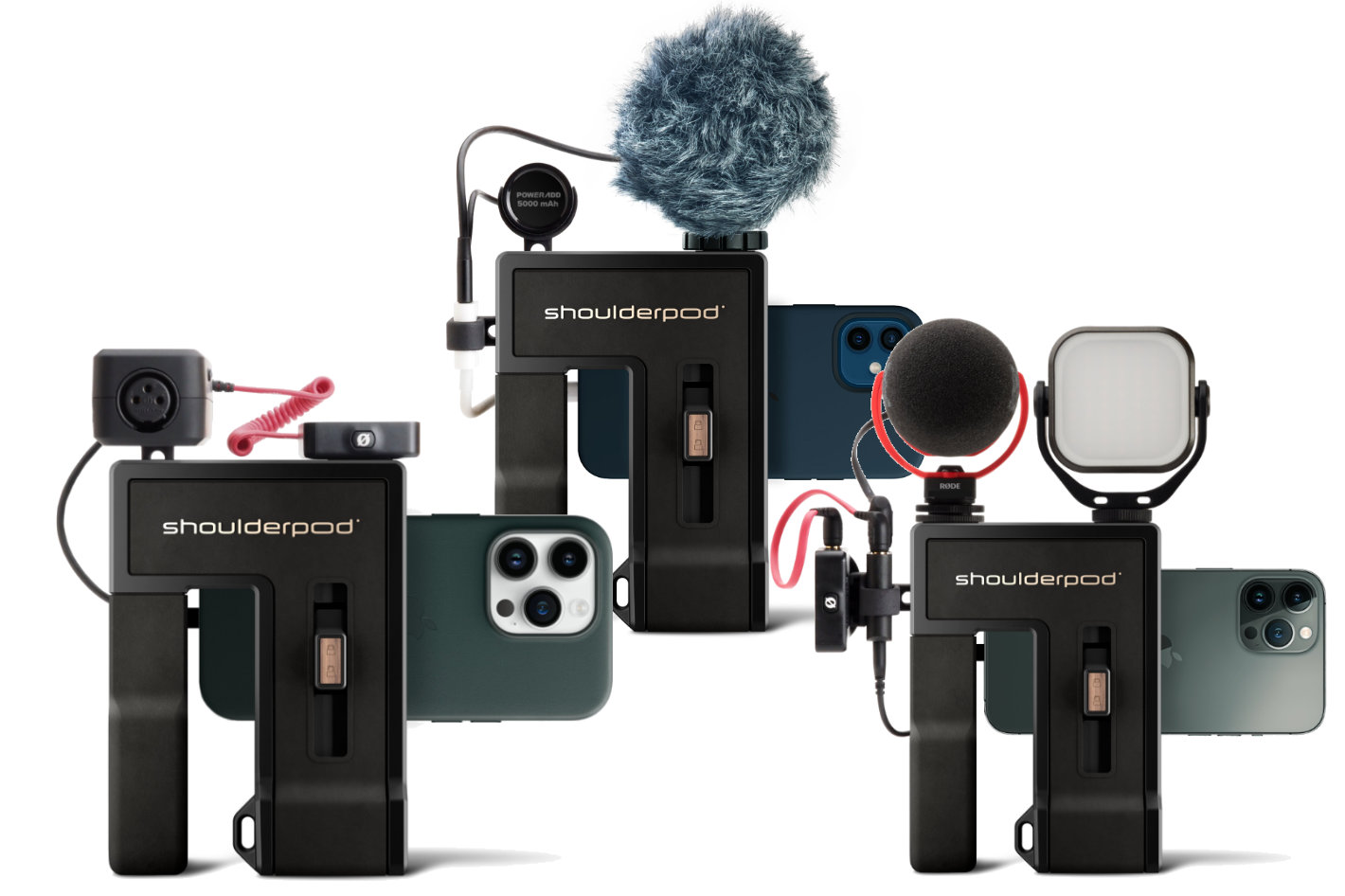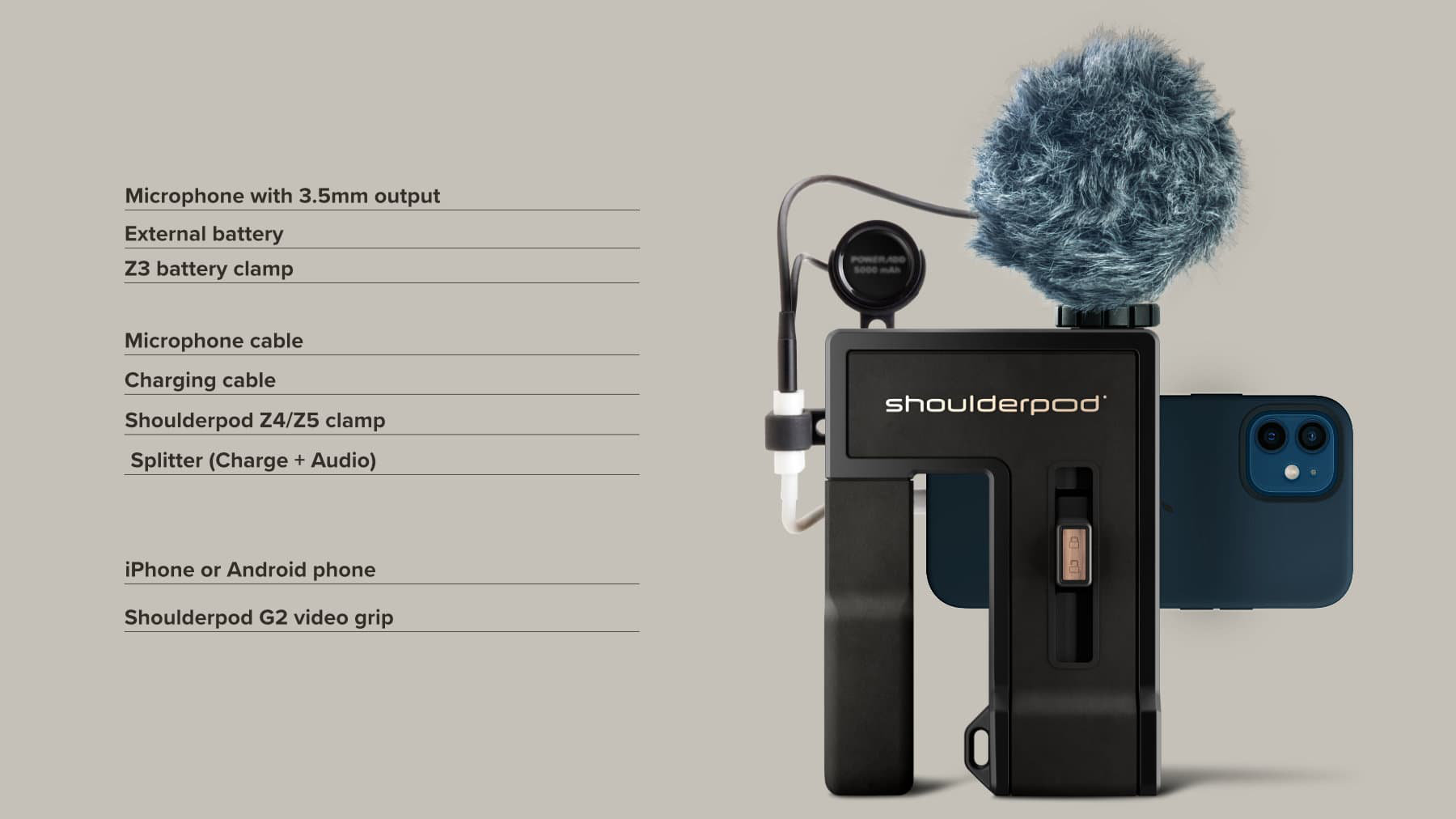
Shoulderpod, the European specialist in smartphone video equipment trusted by more than 130.000 professionals from around the world has helped journalists, newsrooms and broadcast corporations make professional videos with their smartphones and are suppliers of the Mobile Journalism kit used by more than 650 BBC Reporters. Now the company is taking a new step to make the capture of video with smartphones easy for anyone, with the introduction of the POD from Shoulderpod.
POD stands for Professional-Oriented Design. A POD is a smartphone video-setup built to solve a common problem faced by a specific group of professionals. Enrique Frisancho, founder at Shoulderpod told ProVideo Coalition that “after 9 years of supplying video-equipment to the best newsrooms around the world, we realized that video is such a powerful communication tool that it should be accessible to any professional with a story to tell.”
The problem is that building a video-kit for your smartphone can be a real challenge, given the huge number of accessories available out there. That’s why, he continues, “at Shoulderpod we’ve done all the hard work of designing, testing and selecting only the best components so you don’t have to. We want you to stop struggling with gear that doesn’t work, so you can fully focus on what’s important: Telling your story.”


The PODs are designed for professionals who want to make great videos without having to become video experts. That includes:
- Journalists
Staff or freelance reporters who want to be completely autonomous for conducting interviews or covering breaking news as they unfold. - Business owners
Small or medium business owners who want to fully unlock the power of video to promote their brand and start growing their business faster. - Communication managers
PR or communication managers from public or private institutions who want to deliver their message effectively to all their stakeholders.
Compatible with iPhone and Android devices, the PODs from Shoulderpod are supported by a series of cables and adapters for being plugged through either Lightning or USB-C connectors. Shoulderpod introduced three PODS: the Power POD, the BBC Mojo POD and the XLR Reporter POD. Although the company offered PODs are a tested combination of parts designed to seamlessly work together for a specific task, users are encouraged to test new configurations and adapt any POD to their unique workflow. For example, it is possible to use other microphones than those suggested, if they have an analog 3.5mm TRS output jack for using the C2000 or C2001 microphone cables.
Nothing is more distressing than setting up your gear for a shooting session, only to discover that your phone’s battery is almost dead. The new Power POD allows you to charge your smartphone while shooting video. The model built around the Shoulderpod G2, introduces a new accessory, the Z3 3D-printed clamp, which has been exclusively designed to fit the G2 cold shoes tightly while holding our 5000 mAh rechargeable battery firmly in place.
The simple accessory solves one problem of the original Shoulderpod G2, and invites users to say goodbye to messy setups and enjoy the experience of shooting video with a neatly organized solution. There is also an external battery suggested, a compact, lightweight, and high-capacity 5000 mAh rechargeable power bank, to keep your smartphone charged while shooting videos. Keep a couple of extra batteries in your bag and you’ll be ready to keep shooting. Shoulderpod says that for added convenience, you should use the C1 or C2 short cables to neatly charge your Android or iPhone devices.
The Z3 3D-printed clamp is one of many accessories added to the new POD offering from the company. It’s not alone, as there are various 3D-printed parts: Z4, Z5, Z6 and Z7. Shoulderpod opted for 3D printing as it allows the company to offer custom-designed products to a small group of customers at an affordable price. This is done by avoiding the high cost of tooling and injection molding, which only make sense for large production runs.
The reliability of 3D printed materials is now on par with traditional manufacturing processes and can even meet automotive and aerospace specifications. While surface quality has drastically improved during the last years, it is important to understand that surface quality of 3D printed parts is not yet as smooth as an injection-molded or machined part would be, but this is only a small price to pay for having access to products that can radically improve our workflow.
Shoulderpod has a series of cables and adapters for Android and iPhone users on smartphones with USB-C connection, but the company also shares information about the adapters and cables specific for those iPhone users who have devices with a Lightning port. The specific needs for different configurations are all explained on Shoulderpod’s website; USB-C splitters, to plug a mic + battery simultaneously, a 3D-printed clamp, Z5, for mounting the Belkin USB-C splitter on your Shoulderpod G2 video grip, a USB-A to USB-C charging cable, and a 3.5mm mic cable for USB-C, to plug external mics to your device. It’s all clearly explained for each different POD configuration.
The BBC Mojo POD replicates the kit used by hundreds of BBC reporters. Plugging two microphones simultaneously while monitoring the actual recording is a challenging task even for the most experienced mobile journalists. To help the BBC address this issue Shoulderpod developed a MOJO solution that not only solves the problem, but also provides an incredibly neat and reliable setup.
Th BBC Mojo POD allows you to build the solution you want with only the parts you need. The suggested configuration includes the Shoulderpod G2, the heart of your video setup, and a 3.5mm audio interface, RODE Ai-Micro, that allows you to connect 2 microphones + headphones to your smartphone Android or iPhone. This means you can capture high-quality audio from one or two independent sources while monitoring in real-time through your headphones.
Another 3D-printed clamp, Z6, for mounting the Rode Ai-Micro audio interface on your Shoulderpod G2 video grip is suggested. In terms of microphones two are suggested: the Rode VideoMic NTG is a broadcast-grade directional microphone or, if you want to go wireless, the Rode Wireless Duo, which features two wireless microphones and a receiver, enabling simultaneous recording of one or two sound sources on independent channels, all without the hassle of dealing with microphone cables.
The third configuration available is the XLR Reporter POD, which is designed to avoid the challenges of plugging XLR microphones to a smartphone. Shoulderpod picked the iRig PRE HD, a portable interface designed for capturing broadcast-grade audio from any XLR microphone directly to your smartphone. It features adjustable gain control, a 48V Phantom-power switch, and a 3.5mm headphone jack for real-time monitoring. For added convenience, it can be easily mounted on your G2 grip using our Shoulderpod Z7 cold-shoe accessory.
With the introduction of the POD concept Shoulderpod invites smartphone users interested in using their devices creatively to “upgrade your smartphone to storymode in 3 easy steps”. A guide on their website helps users to pick the right combination, and a chat button invites users to pose questions to the team regarding some of the options, so each user can build the perfect setup for their needs.


